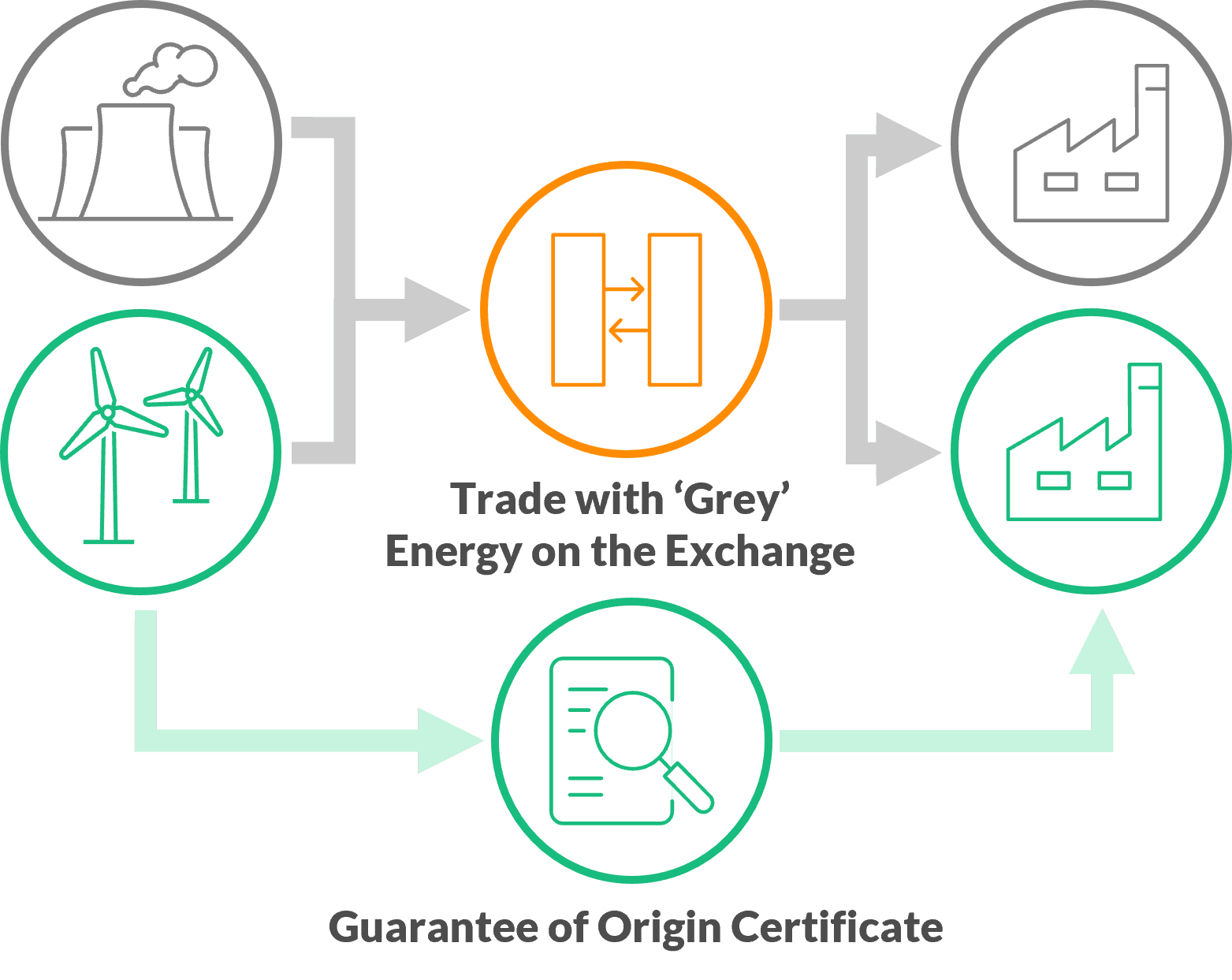09.09.2023 / 09:09
Guarantees of Origin Demystified – Part 2: Guarantees of Origin for Renewable Energy
Energy Markets

This article is the second installment in our series exploring how energy consumers can be provided with assurance that the renewable energy they purchase is indeed obtained from renewable sources. Specifically, this article provides an overview of EU Guarantee of Origins (GoOs) certification and an explanation of the book & claim principle along which GoOs are transferred and canceled.
A GoO is a digital certificate that serves as a guarantee that 1 MWh of energy (a) has been produced by a renewable energy power plant and, (b) has only been marketed once. GoOs were introduced in the European Union in 2001 (Directive 2001/77/EC) and were subsequently defined in Article 2 of the Renewable Energy Directive (RED) 2009/28/EC. In 2018, the EU revised the Renewable Energy Directive (2018/2001/EU), also known as RED II, further strengthening the GoO system toward advancing its 2030 climate goals. Traditionally GoOs have been focused exclusively on electricity - RED II has however also made the introduction of GoOs mandatory for gasses (which includes hydrogen) as well as heating and cooling.
RED II furthermore lays out the fundamental elements of the GoO system's design, including its underlying purpose, the obligation for member states to facilitate the issuance of GoOs as well as their seamless cross-border transferability. The directive further dictates that a GoO must, at minimum, include information on the energy source, sector and information on the specific generator that produced the applicable unit of energy. To foster a dependable structure that allows confident trade between countries, certificates are standardized through the European Energy Certificate System (EECS), provided by the Association of Issuing Bodies (AIB). The CEN EN16325 standard, developed in 2013, aligns the key principles and crucial facets of the GoO system's building blocks in a standardized manner.
The Book & Claim Principle
The issuance and cancelation of GoOs function according to the book & claim principle, which is a chain of custody model where the flow of an administrative record does not necessarily correspond to the physical flow of a material through the supply chain. A GoO certificate is thereby issued for the production of renewable energy, and later canceled upon final consumption. Therefore, GoOs are sold independently to the physical sale and transfer of energy. This allows renewable energy producers to market the green characteristics of their products for the generation of additional revenue, even if generated energy (usually electricity) is fed into the network as ‘grey’. The book & claim principle is illustrated in the figure below:

The reason for the book & claim principle in the marketing of GoOs is that energy carriers such as electricity are homogenous goods that are typically transported across complex infrastructure, and are frequently purchased and resold. This makes identifying the origin of a specific unit of an energy carrier exceedingly difficult at the point of use. Consider the following example: an electricity network is a highly dynamic and coarsely delimited system consisting of multiple generators and consumers whose production and consumption patterns are, though balanced, in constant flux. Electricity takes the shortest route to satisfy a given load demand at a given time, making it impossible to determine the exact origin of a certain unit of power that has been consumed – unless a consumer is directly connected to a given generator, located on-site.
The Benefits and Uses for Guarantees of Origin Certificates
Through the purchase of a GoO certificate, electricity consumers are able to exert their consumer power and lend support to specific power plants, technologies, locations, recent construction projects, and official labels. This enables renewable energy generators to receive revenue from the sale of the renewable quality of the produced electricity, in addition to the sale of electricity volumes on the market. Indeed, purchasing GoOs in addition to renewable energy enables businesses and suppliers to have tangible – and verified - proof of such purchases.
In industry, motivations for the purchase of GoOs may include:
Marketing the renewable quality characteristics in the sale of green power products.
Reliable verification for accounting of greenhouse gas emissions – e.g. using widely accepted standards such as ISO 14064, the Global Reporting Initiative, the Carbon Disclosure Project, or the GHG Protocol
Fulfilling regulatory requirements – e.g. duty of care that extends to the entire supply chain or UE Corporate Social Responsibility guidelines.
Fulfilling sustainability objectives both internally adopted and those of potential clients, many of whom use carbon footprint as a criterion in tender evaluation.
Image and band improvement by demonstrating to customers, financial partners, and investors committed to environmental and climate responsibility.
In Germany, GoOs are used in the fuel disclosure mix provided to energy users on their annual bills as discussed in the previous post of this series.
To be able to choose between technologies like solar, wind, hydro, geothermal, or bioenergy. Indeed, it has been noted by several analysts that the majority of GoO trade, especially between Germany and Nordic countries, is for hydroelectricity. Hydroelectricity is an established technology that does not contribute to the development of new renewable energy generation capacity e.g. solar and wind.
In conclusion, the EU's Guarantee of Origins (GoOs) system is a vital tool in assuring consumers of renewable energy authenticity. With the book & claim principle at its core, GoOs support renewable energy producers, enable informed consumer choices, and advance sustainability goals. As GoOs continue to gain prominence in the energy landscape, they offer a transparent path toward a greener future in line with the EU's climate objectives. The next installment in this series will do a deep-dive into Germany’s registry of GoOs (Herkunftsnachweisregister).
